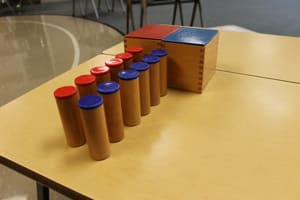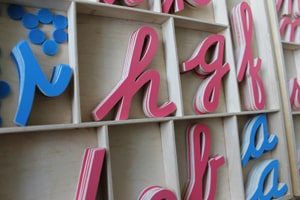Children’s House
Children between the ages of three to six are in a developmental period when they are particularly sensitive to taking in information. Children in this stage of life appear to absorb information nearly effortlessly from the environment surrounding them. Dr. Maria Montessori used the term “Absorbent Mind” to describe this amazing phenomenon. We take advantage of this natural occurring ability at our Children’s House by providing hands-on, self-directed, self-correcting Montessori materials in our classrooms to allow students to learn and comprehend different concepts through doing, touching, and experiencing. Our teachers are specially trained to offer guidance and lessons that ensure exposure to a broad range of activities, and allow each child to follow his/her own interests at their own pace.
Ideally, a child enters our Chilldren’s House program as a three year old and remains in that same environment for three consecutive years. A consistent environment, with the same teachers for three years, encourages children to grow and learn at their own pace, rather than one that has been pre-determined based on their age.

By the time a child has completed a three-year Montessori Children’s House cycle, that child will probably be reading, and calculating with the four basic mathematical operations. This child will be comfortable working independently, as well as acting as a leader and being part of a group, and be focused enough to concentrate on and complete a complex series of tasks happily. This is truly an astonishing period of time!
Curriculum Focus

Practical Life

Sensorial Exercises
These materials are designed specifically to awaken children’s senses, and enable them to gain an awareness of the world around them. These materials isolate individual sensorial concepts, and make each concept distinct and understandable. These specifically designed materials define weight, size, shape, colour, sound, smell, and texture. With an awareness of these concepts, the child develops clear and detailed vocabulary with guidance from their teachers.

Language
Children are introduced to the phonetic sounds of the letters, which gives them the tools they need to understand written language. Children are exposed to both the mechanical and expressive part of written language at the Children’s House level. Tracing letter shapes made of sand paper and working with metal insets prepare children for the mechanical part of the writing. When ready, children are encouraged to create stories that demonstrate the expressive part of writing.
Students at the Casa begin reading during this stage of development, and proceed at their own pace. Grammar and different parts of speech are taught with concrete examples that keep the children more engaged with the concepts. The Children’s House students’ oral language ability continues to grow and develop, with clear and precise vocabulary incorporated in all aspects of classroom activity. Language ties into all aspects of a Children’s House classroom.

Math
Through specially designed Montessori materials, Children’s House students are introduced to the world of arithmetic in a logical, concrete, understandable manner. Each and every math idea, from quantity to the idea of zero, to the concept of odd and even numbering and different hierarchies of numbers, is expressed in a concrete form. With real life examples, students can manipulate and internalize these concepts. In this way, children are intrigued and drawn into mathematics rather than intimidated or confused. Addition, subtraction, multiplication, and division are introduced in concrete ways at an individualized pace for each child. After children gain a solid understanding of math concepts such as the four operations, they are introduced to more abstract math.

Cultural Studies
Our cultural studies include geography, science, history, zoology, botany, and art. Culture is woven into the other areas of the classroom. Children are introduced to the cosmic theory and peace education. Children really enjoy learning about different cultures and traditions, tasting food from different countries and learning their songs, dances, folktales, and more. Additionally, the amazing diversity of the Pine Lake Montessori School community makes culture come alive, and makes children more aware of our global community.

French
PLMS Children’s house students learn French on a daily basis. French Vocabulary and daily conversation is implemented daily through games and Plays. The acquisition of French language is a pleasurable experience for the students and is observed through spontaneous singing of French songs and using French vocabulary to describe objects around them.
